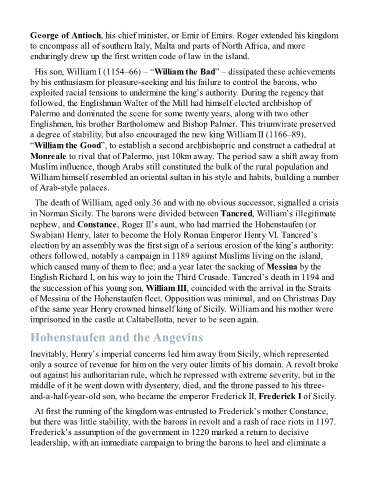Page 566 - The Rough Guide of Sicily
P. 566
George of Antioch, his chief minister, or Emir of Emirs. Roger extended his kingdom
to encompass all of southern Italy, Malta and parts of North Africa, and more
enduringly drew up the first written code of law in the island.
His son, William I (1154–66) – “William the Bad” – dissipated these achievements
by his enthusiasm for pleasure-seeking and his failure to control the barons, who
exploited racial tensions to undermine the king’s authority. During the regency that
followed, the Englishman Walter of the Mill had himself elected archbishop of
Palermo and dominated the scene for some twenty years, along with two other
Englishmen, his brother Bartholomew and Bishop Palmer. This triumvirate preserved
a degree of stability, but also encouraged the new king William II (1166–89),
“William the Good”, to establish a second archbishopric and construct a cathedral at
Monreale to rival that of Palermo, just 10km away. The period saw a shift away from
Muslim influence, though Arabs still constituted the bulk of the rural population and
William himself resembled an oriental sultan in his style and habits, building a number
of Arab-style palaces.
The death of William, aged only 36 and with no obvious successor, signalled a crisis
in Norman Sicily. The barons were divided between Tancred, William’s illegitimate
nephew, and Constance, Roger II’s aunt, who had married the Hohenstaufen (or
Swabian) Henry, later to become the Holy Roman Emperor Henry VI. Tancred’s
election by an assembly was the first sign of a serious erosion of the king’s authority:
others followed, notably a campaign in 1189 against Muslims living on the island,
which caused many of them to flee; and a year later the sacking of Messina by the
English Richard I, on his way to join the Third Crusade. Tancred’s death in 1194 and
the succession of his young son, William III, coincided with the arrival in the Straits
of Messina of the Hohenstaufen fleet. Opposition was minimal, and on Christmas Day
of the same year Henry crowned himself king of Sicily. William and his mother were
imprisoned in the castle at Caltabellotta, never to be seen again.
Hohenstaufen and the Angevins
Inevitably, Henry’s imperial concerns led him away from Sicily, which represented
only a source of revenue for him on the very outer limits of his domain. A revolt broke
out against his authoritarian rule, which he repressed with extreme severity, but in the
middle of it he went down with dysentery, died, and the throne passed to his three-
and-a-half-year-old son, who became the emperor Frederick II, Frederick I of Sicily.
At first the running of the kingdom was entrusted to Frederick’s mother Constance,
but there was little stability, with the barons in revolt and a rash of race riots in 1197.
Frederick’s assumption of the government in 1220 marked a return to decisive
leadership, with an immediate campaign to bring the barons to heel and eliminate a

